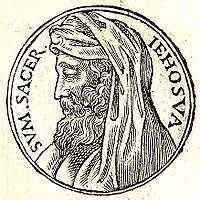Joshua the High Priest
Joshua (Hebrew יְהוֹשֻׁוּעַ Yəhōšua‘) or Yeshua the High Priest was, according to the Bible, the first person chosen to be the High Priest for the reconstruction of the Jewish Temple after the return of the Jews from the Babylonian Captivity (See Zechariah 6:9–14 and Ezra 3 in the Bible). While the name Yeshua is used in Ezra–Nehemiah for the High Priest,[1] he is called Joshua son of Yehozadak in the Book of Haggai and the Book of Zechariah.[2]
| Part of a series of articles on |
| Priesthood in Judaism |
|---|
| |
|
Kohen · Recognition of priestly descent Priestly covenant |
|
High Priests Aaron · Eleazar · Phinehas · Eli · Ahimelech · Abiathar (First Temple) · Zadok · Shallum · Hilkiah · Jehoiada (Second Temple) Joshua the High Priest Simeon the Just Yishmael Ben Elisha Yehoshua ben Gamla Pinchus Ben Shmuel |
|
Twenty-four kohanic gifts The ten gifts given in the Temple 1. Sin offering · 2. Guilt offering 3. Communal peace offering 4. Fowl sin offering · 5. Leftovers from the suspensive guilt offering 6. Oil from the offering for the leper 7. Bread from First Fruits · 8. Showbread 9. Leftovers of the meal offering 10. Leftovers of the First Sheaf.
15. Heave offering 16. Heave offering of the Levite's tithe 17. Dough offering 18. First shearing of the sheep 19. Shoulder, cheeks and maw 20. Coins for redemption of the first born son · 21. Redemption of a donkey · 22. Dedication of property to a priest · 23. Field not redeemed in a Jubilee year · 24. The property of the foreigner with no heir. |
|
Priestly Garments |
|
Miscellaneous topics The Mitzvah of sanctifying the Kohen Kohanic disqualifications Holy anointing oil Kahen Aaron's rod Bat-Kohen (daughter of a kohen) Sons of Zadok Contact by a kohen with a dead body 13 Kohanic cities |
Life
Joshua son of Jozadak served as High Priest ca. 515–490 BCE in the common List of High Priests of Israel. This dating is based on the period of service at age 25–50 (per Numbers 8) rather than age 30–50 (per Numbers 4).
The biblical text credits Joshua among the leaders that inspired a momentum towards the reconstruction of the temple, in Ezra 5:2. Later 10:18 some of his sons and nephews are found guilty of intermarriage.
Facts concerning the later part of Joshua's life are in part dependent upon whether Joshua was still alive at the time of his appearance in a vision seen by Zechariah. If the vision relates to Nehemiah's cleansing of the temple in 13:28 then the engagement of Joshua's great-great-grandson to the daughter of Sanballat the Horonite would place Joshua in his late 90s if he were still alive.[3]
Appearance in vision
In the Book of Zechariah 3:6–10, Zechariah the prophet experiences a vision given to him by an angel of the Lord in which the restoration and cleansing of Joshua's priestly duties are affirmed. Included in the visions were requirements in which Joshua was expected to uphold. These included: (1) walk in the ways of God, (2) keeping the requirements (the law), (3) ruling God's house, (4) take charge of my courts; by fulfilling these duties, the angel in the Book of Zachariah granted access to the inner temple to Joshua and his fellow priest. The vision also functioned to purify Joshua and to sanctify him for the preparations of his priestly duties.
Alternatively, if Joshua had in fact died before the events of Nehemiah 13, then it is possible that the vision intended to depict a heavenly throneroom scene of Satan and the angel disputing over the soul of Joshua, and the intended target of the allegory is the then serving high priest, his grandson, Eliashib.[4]
Tomb
In 1825, the traditional tomb of Joshua was reported to have been found at "one hour's distance from Baghdad."[5]
See also
- Related Bible parts: Haggai 1, Haggai 2, Zechariah 3
Notes and references
- http://www.kingjamesbibleonline.org/Ezra-Chapter-3/
- David Noel Freedman, Allen C. Myers, Eerdmans Dictionary of the Bible, Amsterdam University Press, 2000, pp. 700–701
- Carol L. Meyers Haggai, Zechariah 1–8 Vol. 25B The Anchor Yale Bible Commentaries 1987
- Meyers, op.cit.
- United Foreign Missionary Society (1825). American missionary register. J. & J. Harper. p. 280. Retrieved 4 October 2010.
External links
- Pictures of tomb of Joshua the High Priest in Iraq, and Courtyard, by Kobi Arami
